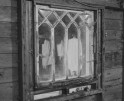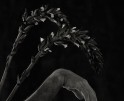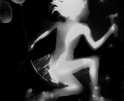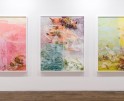Some months ago, I received the beautiful book,
Earth Meets Spirit, in the mail. I was familiar with the name
Douglas Beasley as I fell in love with this image that graced the cover of
SHOTS Magazine sometime back, but I wanted to learn more about him.
Known for his Vision Quest workshops and stunning photographs about Native Americans and the American West, Douglas is someone who has found a place in the world where the earth meets spirit. He lives in a passive solar home surrounded by trees in Saint Paul, MN and when not out traveling the world he can be found tending his Japanese gardens or enjoying a strong cup of coffee while listening to loud music.
Douglas received a BFA from the University of Michigan, Ann Arbor where he also studied Eastern Religions and Native American culture. After working in a variety photo studios, he opened his own in Minneapolis, MN with an emphasis on commercial and editorial fashion. As a strong feminist, he considers himself the world’s most unlikely fashion photographer. This evolved into shooting throughout the country for various advertising, educational, public service and non-profit clients. He currently works on fine-art based commercial projects around the world.
He has been published internationally and featured in numerous photo magazines such as Zoom, The Sun, B&W, PDN and PhotoVision. His first book Japan; A Nisei’s First Encounter, offers insight into his journey to his mother’s Japanese homeland. His most recent book Earth Meets Spirit was recently published by 5 Continents Editions in Milan, Italy and is distributed by Abrams.
As founder and director of Vision Quest Photo Workshops, Beasley provides workshops that emphasize personal expression and creative vision over the mechanics of camera use. His upcoming workshop, Zen and the Art of Photography at Breitenbush Hot Springs in Oregon is running September 16th -21st. Douglas has also created Vision Quest cards that help keep photographers motivated.

INTERVIEW
Tell us a little bit about your growing up and what brought you to photography?
I grew up in suburban Detroit, the only Asian kid in an all white school. This sense of being different really was fundamental to my growing up and at least perceiving myself as an outsider and as an observer, since I knew I wasn’t like the other kids and didn’t quite fit in.
How did the book come about? And can you explain the title and concept?
My photography is about recognizing the spirit that inhabits all things, animate and inanimate, big and small. The book originally was a request from my gallery in Italy for a printed collection of my photographs so they could better define and market me in Europe. It came together as a result of melding together various past bodies of work while trying to find the thread that ties them together. I worked very closely with graphic designer Krista Matison. She is a good friend from my past and we had always worked well with together. She really ‘gets’ my style and sensibility but also keeps me grounded in the world of realistic possibility. The title Earth Meets Spirit originally came from Daniel Kantor, a graphic designer/strategic marketing specialist and good friend, who came up with it to describe me and my work while designing my new letterhead and website. It seemed to encapsulate so much with so few words.
You seem to be drawn to a Native American sensibility, though your mother is from Japan. Do these two cultures intersect for you?
Yes, completely. Although they both have very different ways of expressing it, both cultures recognize that everything has a spirit, even rocks and trees. I found many other similarities in the spirituality of both cultures, which is why I find myself inextricably drawn to both cultures spiritual expression as well as to Japanese design sensibility.
Spirituality is a big part of your work and you look at the world from a sacred perspective. How has this perspective changed you?
It has let me explore what I want to learn more about. It gives me the excuse to keep looking. I don’t know the answers but through pursuing various photo projects I get to live the questions out loud. Photography gives me permission to explore spiritual themes and concepts deeper and with more intent.
There is a timeless, slowed down quality to your images. What cameras do you use, and what is your approach to making photographs?
Although I shoot digital on commercial assignments, I still use film for all my fine art work. It slows me down and keeps me very present. The preciousness of 12 frames on a roll before you have to re-load makes you be careful but the knowledge from the old days that “film is cheap’ compared to everything else in photography (not to mention what it took to arrive at a particular destination) helps me let go and abandon that sense of preciousness.
How do you divide your time between doing commercial work, your personal work, and teaching workshops?
I do very few commercial assignments these days, but when I get one it tends to be a good one, usually involving travel. Commercial assignments are a challenge. You are forced to be creative on somebody else’s timetable and on somebody else’s chosen location. There are no excuses. You have to make it work. That is great discipline for doing one’s artwork where there can be a multiplicity of excuses. In commercial work you don’t have the luxury of those excuses and I try and carry that sense of making the here and now work in personal photography.
Teaching and workshops have become a much bigger part of my creative life and the time and destinations have become a big part of where and when I do my personal work.
I love your quote, “Photographs symbolize the beauty that resides in all things, the spirit that inhabits all objects, the temporal nature of life experiences.” Are you able to find these qualities in contemporary digital photography, or is this statement a more personal reflection of you own vision?
Yes, digital or film, it’s just a choice of tools. They both still require an eye, a heart and a soul. The only real difference it what happens logistically after you click the shutter. Am just not a fan of sitting endlessly in front of a computer editing. I find the natural stages of film; processing, looking over contact sheets, editing, printing; more personally conducive to my own timetable for getting to know what I have photographed and what works and what doesn’t. I like the extra time this takes. It can remove me, in a healthy way, from the moment of exposure and yet with the passage of time I can stay connected to hear what the images have to say on their own.
What advice can you give to emerging photographers on getting their work out into the world?
Take the time and do the work to learn the craft of photography. Think about the quality of the photos first, the emerging body of work second, the context within the medium or our society third and when and where to share them last. Don’t put the cart (gallery or exhibit space) before the horse (quality, context and meaning). Then share your unique perspective and put the work out there that youwant others to see not what you think others might want to see. Be very careful who you take advice from. Develop and learn to trust your own instincts. But remember those instincts are honed by education, experience and the advice of trusted mentors or colleagues. Don’t be afraid to change your mind, your opinion, your exposure, your composition, or your frame of reference as necessary.
How does one find an authentic visual voice?
Practice. Abandon attachment to results. Risk failure. Repeat as necessary. Invest in the time it takes to really get to know your self. Listen to others when necessary. More importantly, ignore others when necessary. Tune in to your own intuition of which of these is right for you at which time. Always see if you can take it one step deeper…
And finally, what would be your perfect day?
Spending a beautiful winter day at my cabin in NW Wisconsin. A long walk or ski in the woods with fresh snow, a fire in the woodstove, a good meal with red wine and friends…


























































































